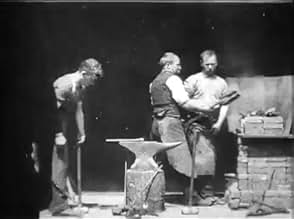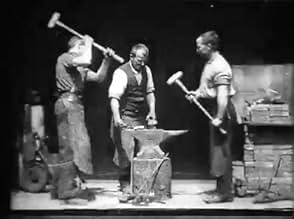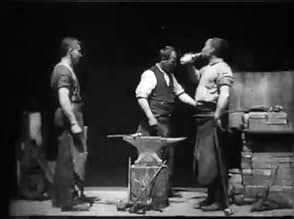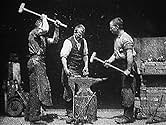VALUTAZIONE IMDb
6,2/10
2955
LA TUA VALUTAZIONE
Aggiungi una trama nella tua linguaThree men hammer on an anvil and pass a bottle of beer around.Three men hammer on an anvil and pass a bottle of beer around.Three men hammer on an anvil and pass a bottle of beer around.
- Premi
- 1 vittoria in totale
Charles Kayser
- Blacksmith
- (non citato nei titoli originali)
Recensioni in evidenza
The footage in this very early movie still looks very good, and it still works as a vignette (albeit a staged one) of life in a bygone era. In itself, it's a simple scene, but it's far from a lifeless one, and the composition works as well.
The scene, which features the leisurely-paced efforts of the blacksmiths as they do their work while occasionally refreshing themselves, is not without a little irony. Even in its day, although the blacksmith shop itself was a familiar sight, the laid-back feel of the scene was deliberately imagined as a throwback to an earlier day, rather than as a picture of the (then) present of the 1890s. (The notes in the new Kino collection of Edison films confirm this.) By contrast, many of the other earliest movies were made with a deliberate emphasis on things of the present.
The images still look quite clear in comparison with some of the other experiments in the earlier 1890s, so it must have looked quite good in its time. Then, it was an intriguing taste of things soon to come. Now, it is a chance to revisit the past.
The scene, which features the leisurely-paced efforts of the blacksmiths as they do their work while occasionally refreshing themselves, is not without a little irony. Even in its day, although the blacksmith shop itself was a familiar sight, the laid-back feel of the scene was deliberately imagined as a throwback to an earlier day, rather than as a picture of the (then) present of the 1890s. (The notes in the new Kino collection of Edison films confirm this.) By contrast, many of the other earliest movies were made with a deliberate emphasis on things of the present.
The images still look quite clear in comparison with some of the other experiments in the earlier 1890s, so it must have looked quite good in its time. Then, it was an intriguing taste of things soon to come. Now, it is a chance to revisit the past.
It's always fascinating to watch movies that are this old because it's like looking a hundred years into the past. You get to see a glimpse of what the world was like a century ago, even though in this particular film all we see is three guys hammering on an anvil. Blacksmith Scene was the first film ever to be shown to a large audience, I think it was something like 200 people who watched it one at a time on a kinetoscope after a lecture by the Edison Company, the creators of the film. Actual projection of movies didn't start until about a year or so later.
There are a lot of interesting things about this film, especially since it's the first one that was made to be shown to a large audience. These are actors in the film, not actual blacksmiths, so it's not even a documentary but it's interesting that the first thing portrayed is actual work. A perfect way to introduce a new medium. Another thing that is pretty interesting is the way they pass around that bottle of beer - even in this earliest of early films, they are striving to entertain. This is not just a moving photograph, but a primitive film that seeks to do exactly what every film made thereafter strives to do - hold the audience's attention. Obviously, it was a lot easier for a moving picture to hold the audience's attention in 1893 than it is today, but in this primitive film all of the major requirements of a film can be found.
Except a plot, of course...
There are a lot of interesting things about this film, especially since it's the first one that was made to be shown to a large audience. These are actors in the film, not actual blacksmiths, so it's not even a documentary but it's interesting that the first thing portrayed is actual work. A perfect way to introduce a new medium. Another thing that is pretty interesting is the way they pass around that bottle of beer - even in this earliest of early films, they are striving to entertain. This is not just a moving photograph, but a primitive film that seeks to do exactly what every film made thereafter strives to do - hold the audience's attention. Obviously, it was a lot easier for a moving picture to hold the audience's attention in 1893 than it is today, but in this primitive film all of the major requirements of a film can be found.
Except a plot, of course...
The Black Maria movie studio at Edison's West Orange, New Jersey laboratory (see comments on "Men Boxing" for a description) was used, from 1892 until 1900, to produce as many as 300 films. "Blacksmith Scene" was filmed in this studio and is generally regarded as the earliest known commercial film. It was filmed by the vertical-feed Kinetograph camera using 1-1/2-inch celluloid film newly developed by the Eastman Company.
To make this film 'commercial', it was necessary to have a way for the public to view it. A Kinetoscope was developed for that purpose. The Kinetoscope (a peep-show machine) was used for a public exhibition; given at a meeting of the Brooklyn Institute of Arts and Sciences on Tuesday May 9th, 1893. Over 400 people lined up to view the film over a two hour period.
To make this film 'commercial', it was necessary to have a way for the public to view it. A Kinetoscope was developed for that purpose. The Kinetoscope (a peep-show machine) was used for a public exhibition; given at a meeting of the Brooklyn Institute of Arts and Sciences on Tuesday May 9th, 1893. Over 400 people lined up to view the film over a two hour period.
By the time Dickson and Edison had produced "Blacksmith Scene", the forming of the Edison company was well underway. Within three years (1890-1892) their hopes of creating motion pictures had become realized, beginning with the blurry, incomprehensible tests of the "Monkeyshines" movies to the clear, smoothly moving "Dickson Greeting" of 1891. (I cannot say much for the 1892 films as many of them appear to be lost completely, and the two remaining ones I've viewed are, shall we say, almost as bad as watching the "Monkeyshines" trilogy for whatever reason). Then came 1893, a year in which little filming in the motion picture industry seemed to take place outside of the two Edison movies "Horse Shoeing" and this film. On the other hand, the events of the year were very big: Edison's Black Maria studio was finally completed and the very first public showing of films in America was held in the Brooklyn Institute of Arts and Sciences. Among the two films to be shown at the institute was "Blacksmith Scene", and despite the fact both films were shown the exact same day and both featured a staged scenario, the other one to be shown ("Horse Shoeing") hasn't had much attribution given to it even though it was labelled as "first successful Edison film" on the three surviving stills known to exist. But I digress...
Yet, despite being only 30 seconds long, this single film (or two films, as I prefer to say) shows quite interestingly enough the potential of motion pictures. In filming these three men hammering at the anvil, the idea of filming fictitious action shows us the possibilities of special effects, of dream worlds, of everything we have today. In that sense we can say it was Edison, not Georges Méliès, who showed such possibilities. There are all sorts of clues to show you this is not a documentary film: take, for instance, the black background. Clearly a real blacksmiths shop would have a brick or cement wall instead. Furthermore, check out the brief swig the blacksmith on the left does, showing us that the bottle is probably quite empty since he would have had to tip his neck back further to drink in real life. The silhouette of the man standing in front of the camera is clearly either an assistant cameraman or a director (Dickson, in this case) directing the action, who must have been told he was blocking part of the scene, or have realized it himself as he soon steps out of the way.
As if those two things weren't enough, "Blacksmith Scene" also began a new silent era movie genre that would be copied several other times over the next couple of years. One of the earliest known remakes (but not the first) was the Lumière Brothers' "The Blacksmiths" which was also historically important as being on of the ten movies shown at the Salon Indien in the December of 1895. In the remake, it is clear some of the scenario was staged but shot in a real location with real blacksmiths, and was less important as a result. This was followed soon after by "Blacksmith in His Workshop", a Georges Méliès documentary of 1896. No comparison to that movie can be made, however, as it remains lost.
Yet, despite being only 30 seconds long, this single film (or two films, as I prefer to say) shows quite interestingly enough the potential of motion pictures. In filming these three men hammering at the anvil, the idea of filming fictitious action shows us the possibilities of special effects, of dream worlds, of everything we have today. In that sense we can say it was Edison, not Georges Méliès, who showed such possibilities. There are all sorts of clues to show you this is not a documentary film: take, for instance, the black background. Clearly a real blacksmiths shop would have a brick or cement wall instead. Furthermore, check out the brief swig the blacksmith on the left does, showing us that the bottle is probably quite empty since he would have had to tip his neck back further to drink in real life. The silhouette of the man standing in front of the camera is clearly either an assistant cameraman or a director (Dickson, in this case) directing the action, who must have been told he was blocking part of the scene, or have realized it himself as he soon steps out of the way.
As if those two things weren't enough, "Blacksmith Scene" also began a new silent era movie genre that would be copied several other times over the next couple of years. One of the earliest known remakes (but not the first) was the Lumière Brothers' "The Blacksmiths" which was also historically important as being on of the ten movies shown at the Salon Indien in the December of 1895. In the remake, it is clear some of the scenario was staged but shot in a real location with real blacksmiths, and was less important as a result. This was followed soon after by "Blacksmith in His Workshop", a Georges Méliès documentary of 1896. No comparison to that movie can be made, however, as it remains lost.
All right, so it's short on plot. But just the fact of this Edison-studio produced film is enough to make it an award-winner. It doesn't have the same pathos as the Edison clip of men dancing used to such great effect in "The Celluloid Closet," but how can you not love a century-old example of "Miller Time"?
Lo sapevi?
- QuizThe mixing of work and alcohol was commonplace in the early 19th century, especially amongst heavy laborers. By the 1890's, however, the practice had died away. The use of the bottle of beer in this film is intended to invoke a sense of comic nostalgia of a bygone era.
- ConnessioniFeatured in Edison: The Invention of the Movies (2005)
I più visti
Accedi per valutare e creare un elenco di titoli salvati per ottenere consigli personalizzati
Dettagli
- Tempo di esecuzione1 minuto
- Colore
- Mix di suoni
- Proporzioni
- 1.33 : 1
Contribuisci a questa pagina
Suggerisci una modifica o aggiungi i contenuti mancanti

Divario superiore
By what name was Blacksmith Scene (1893) officially released in India in English?
Rispondi




















